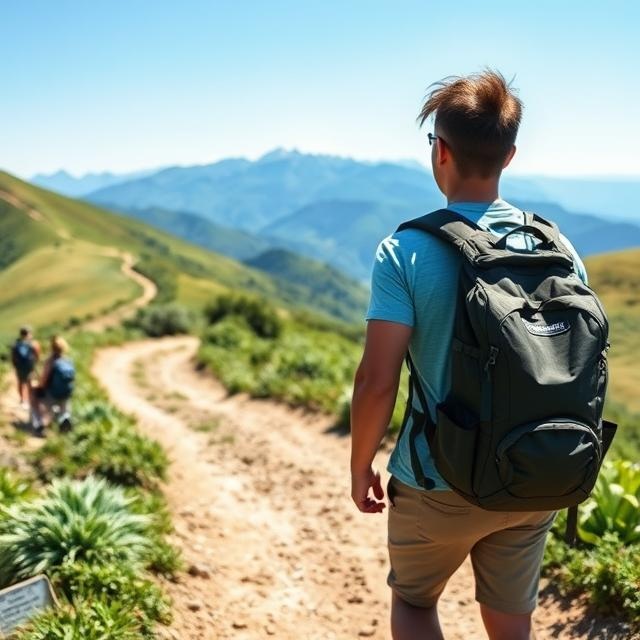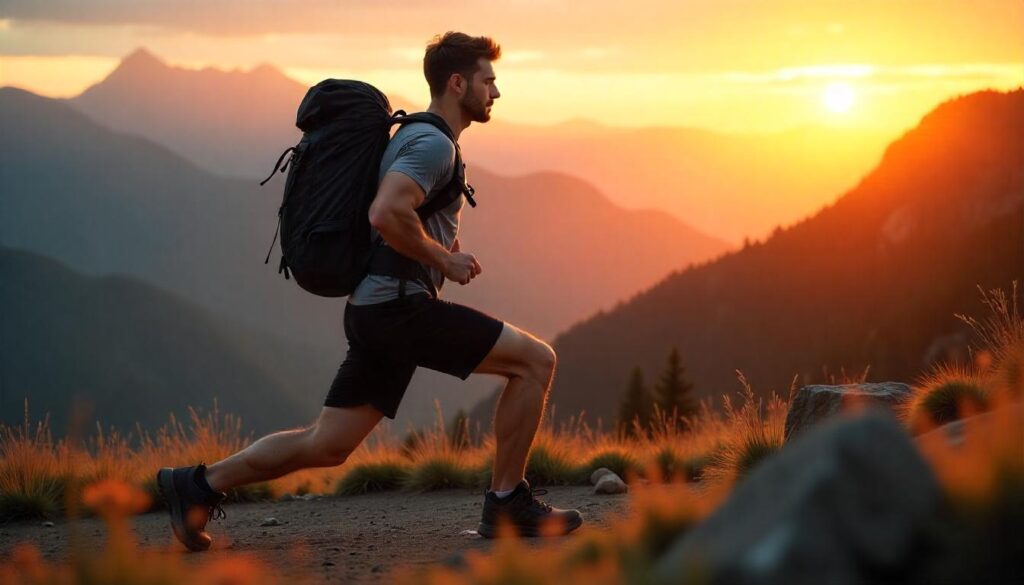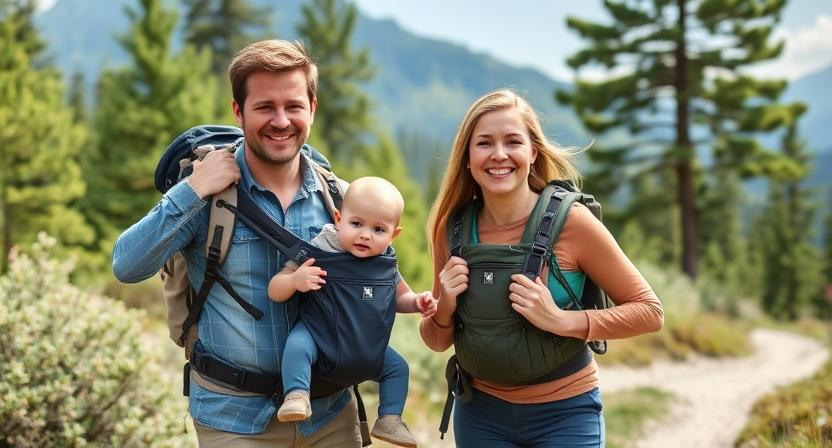
Hiking with a baby may seem daunting at first, but with the right preparation and mindset, it can be one of the most rewarding experiences for both parents and little ones. Taking your baby on hikes not only helps you stay active but also introduces your child to the beauty of nature from an early age. Whether you’re trekking through scenic forests, strolling along gentle trails, or venturing into the mountains, hiking with a baby strengthens family bonds and promotes a love for the outdoors.
Many parents hesitate to hike with their baby due to concerns about safety, necessary gear, and how far they can realistically go. Is it safe to take a newborn hiking? What essentials do I need? How long can a baby or toddler stay on the trail? These are all valid questions, and this guide will provide expert-backed answers and practical tips to make hiking with your baby both safe and enjoyable.
From understanding the best age to start, ensuring safety at each stage, and choosing the right gear, this guide covers everything you need to know to confidently embark on outdoor adventures with your little one.
Can You Hike with a Baby? Understanding Age, Safety & Preparation
When Can Babies Start Hiking?
Babies can start hiking at any age, but how you approach the hike depends on their developmental stage. Here’s a breakdown by age:
- Newborns (0-3 months): At this stage, babies have delicate immune systems and require frequent feeding and diaper changes. It’s best to stick to short, easy hikes on smooth trails to avoid excessive jostling. A front-facing baby carrier with proper head and neck support is essential for comfort and safety.
- Infants (3-12 months): As babies develop better head and neck control, longer hikes become more feasible. A structured baby carrier with good lumbar support can help distribute weight more evenly, making it more comfortable for parents. Babies at this stage are curious and will enjoy looking around, so consider choosing trails with plenty of visual stimulation.
- Toddlers (12+ months): At this stage, many babies are eager to explore on their own. While hiking with a toddler means taking frequent breaks, it’s a great opportunity to let them walk short distances and develop their motor skills. Trails with flat, even terrain are ideal to prevent falls.
Regardless of age, always consider the weather, your baby’s comfort, and trail difficulty before heading out.
Safety Considerations by Age
Hiking with a baby requires extra precautions to ensure their well-being. Here’s how to keep your little one safe at every stage:
- Newborns: Temperature regulation is critical, as babies this young cannot adjust to extreme cold or heat. Always dress them in breathable layers and keep them protected from direct sun exposure.
- Infants: Babies at this stage can become fussy if they’re too hot, cold, or uncomfortable. Choose well-ventilated carriers for warm-weather hikes and insulated ones for colder temperatures. Bring plenty of fluids (if formula-fed) and be prepared for more frequent snack breaks.
- Toddlers: Once your baby is walking, be mindful of uneven terrain and ensure they wear proper hiking shoes to prevent slipping. Keep a close eye on them near water bodies, steep slopes, or rocky areas. Consider using a toddler hiking harness in crowded trails to prevent them from wandering off.
Regardless of your baby’s age, always carry a basic first-aid kit, sun protection, and extra clothing. Keeping safety in mind allows for a stress-free and enjoyable hiking experience.
How Far Can Young Kids Hike?
Hiking distances vary based on your baby’s age, stamina, and comfort level. Here’s a general guideline:
- Newborns (0-3 months): 0.5 – 1 mile (20-30 minutes)
- Infants (3-12 months): 1 – 3 miles (45 minutes – 1.5 hours)
- Toddlers (12+ months): 1 – 5 miles (Depends on their walking ability and energy levels)
Since hiking with a toddler often means more stops, plan for double the time you’d normally take on the same trail. Choosing trails with scenic spots like waterfalls or streams can help keep them engaged.
While these distances are good starting points, every baby is different. It’s best to start with short, easy hikes and gradually increase difficulty as your child gets used to being outdoors.
Essential Gear for Hiking with a Baby
Choosing the right gear makes hiking with a baby safer and more enjoyable. From baby carriers to clothing and accessories, here’s everything you need to know before hitting the trails.
Baby Carriers for Hiking – How to Choose the Best One

A good baby carrier is the most essential piece of baby hiking gear. It provides comfort, safety, and convenience while allowing parents to hike hands-free. Choosing the right type of carrier depends on your baby’s age, hike duration, and personal comfort preferences.
Soft-Structured vs. Framed Backpacks – When to Use Each
- Soft-Structured Carriers (SSCs) are ideal for infants and short hikes. These are ergonomic, close to the body, and provide better head support for newborns.
- Framed Hiking Backpacks are designed for toddlers and longer hikes. These offer better weight distribution, padded straps, sunshades, and storage compartments.
Top Features to Look For in a Hiking Carrier
When choosing a hiking carrier for babies, prioritize:
- Weight Capacity – Ensure it supports your baby’s current and future weight.
- Adjustability – Padded straps and lumbar support for parental comfort.
- Ventilation – Mesh panels or breathable fabric to prevent overheating.
- Sun Protection – Integrated sunshades or attachable rain covers.
- Storage Options – Pockets for snacks, diapers, and baby essentials.
Best Baby & Toddler Hiking Carriers (2024)
Some of the best hiking carriers this year include:
- Osprey Poco Plus – Best for long hikes, great lumbar support.
- Deuter Kid Comfort Pro – High safety rating, built-in sunshade.
- Ergobaby Omni 360 – Soft-structured, best for newborns.
Clothing & Footwear for Baby Hikers

Dressing your baby properly ensures they stay comfortable and safe throughout the hike. Since babies and toddlers can’t regulate temperature as well as adults, layering and weather-appropriate clothing are key.
Dressing for the Season – Layering for Winter vs. Summer Hikes
- Winter Hikes – Use a three-layer system: moisture-wicking base, insulating mid-layer (fleece or down), and waterproof outer shell. Don’t forget gloves and a warm hat!
- Summer Hikes – Opt for light, breathable clothing with UV protection. Long sleeves and pants help protect against sunburn and bug bites.
Best Baby & Toddler Hiking Shoes
Baby feet are still developing, so choosing appropriate footwear is crucial.
- For infants – Soft, flexible booties provide warmth but aren’t necessary for non-walkers.
- For toddlers – Look for hiking shoes with grippy soles, ankle support, and waterproofing.
- Best toddler hiking shoes (2024):
- Keen Newport H2 Sandals – Perfect for summer hikes & water play.
- Merrell Trail Chaser – Durable and supportive for rugged terrain.
- Salomon XA Pro 3D – Lightweight trail runners with excellent traction.
Must-Have Baby Hiking Accessories
Beyond clothing and carriers, a few essential accessories can make hiking with a baby smoother and stress-free.
Baby Sun Protection – Hats, Sunscreen & Bug Repellent
- Sun Hats – Wide-brimmed hats with adjustable straps help shade your baby.
- Baby-Safe Sunscreen – Use mineral-based sunscreens (SPF 30+), as they are gentler on baby skin.
- Bug Repellent – Choose DEET-free options or natural insect repellents like lemon eucalyptus oil.
Snack & Hydration Essentials
Keeping your baby hydrated and well-fed is crucial for a happy hike.
- Hydration Packs for Kids – Lightweight, hands-free water bladders for toddlers.
- Baby-Friendly Snacks – Fruit pouches, cereal bars, and teething biscuits are easy to carry.
First Aid Kit & Emergency Supplies
A well-packed first aid kit should include:
- Baby-safe pain relievers (Tylenol/Ibuprofen)
- Band-aids, antiseptic wipes, and tweezers
- Emergency whistle and baby emergency contact card
Comparison of Best Baby Hiking Gear (Table)
| Item | Best For | Features | Recommended Brand |
| Baby Carrier | Long hikes, toddlers | Framed, sunshade, storage | Osprey Poco Plus |
| Soft Carrier | Infants, short hikes | Ergonomic, breathable, close fit | Ergobaby Omni 360 |
| Hiking Shoes | Rugged terrain | Waterproof, good traction | Merrell Trail Chaser |
| Sun Hat | Sun protection | Wide brim, adjustable fit | Sunday Afternoons |
| Hydration Pack | Toddlers, easy access | BPA-free, lightweight | CamelBak Mini M.U.L.E. |
How to Hike Safely with a Baby
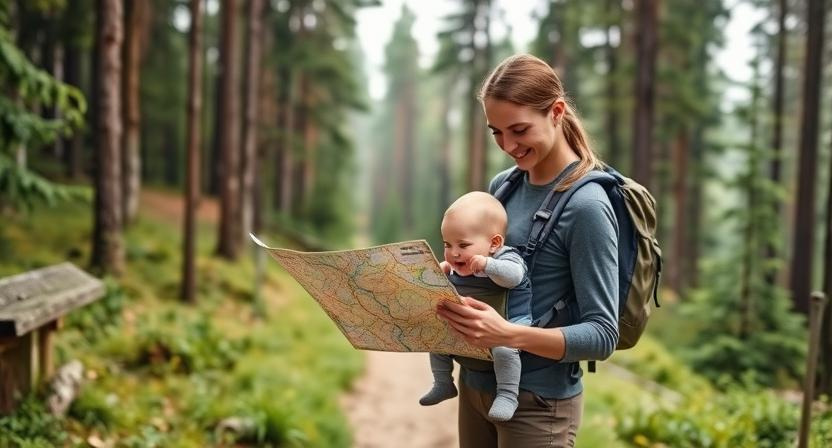
Hiking with a baby requires extra safety precautions to ensure a stress-free and enjoyable adventure. Here’s how to prepare and manage safety on the trail.
Preparing for the Hike
- Choosing the Right Trail – Pick easy, well-maintained trails with minimal elevation gain and plenty of shade. Avoid rocky, technical paths for safety.
- Checking Weather Conditions – Babies are more sensitive to extreme weather. Avoid hikes in extreme heat or cold, and always check forecasts before heading out.
- Backup Plan – Always have an exit strategy in case of unexpected situations like bad weather, baby discomfort, or fatigue.
Hiking Strategies with a Baby
- Managing Feeding, Naps & Diaper Changes on the Trail –
- Plan hikes around nap & feeding schedules to avoid fussiness.
- Breastfeeding or bottle-feeding? Find shaded, quiet spots to take breaks.
- Carry a lightweight, foldable changing mat for quick diaper changes.
- Signs of Baby Discomfort & When to Stop –
- Watch for signs of overheating or dehydration (flushed skin, fussiness).
- If your baby seems overwhelmed or overstimulated, take a break or shorten the hike.
- Always listen to your baby’s cues – if they’re unhappy, it’s okay to cut the hike short!
Best Baby-Friendly Hikes by Age Group

Finding the right trails for your little one can make hiking an enjoyable experience for both parents and babies. The best trails vary by age, from gentle stroller-friendly paths for newborns to interactive nature trails for toddlers.
0-6 Months – Flat Trails, Shaded Paths & Short Scenic Hikes
At this stage, your baby is still adjusting to the outside world. Since newborns have delicate immune systems and limited temperature regulation, it’s best to keep hikes short, shaded, and smooth. Sticking to easy, stroller-friendly trails ensures a safe and comfortable outing.
Newborns spend a lot of time sleeping, so a quiet, scenic hike can be a relaxing experience for both parents and babies. Look for wide, flat trails with minimal elevation gain, preferably near calm lakes, gentle streams, or forested areas that provide shade. Since babies at this stage need frequent feeding and diaper changes, choose a hike close to facilities like picnic areas or visitor centers.
Best Hikes for Newborns (0-6 Months):
- Paved Park Loops – Many urban parks have stroller-friendly walking loops with smooth surfaces.
- Lakeside Trails – Calm water sounds can be soothing for infants, and these trails often have scenic resting areas.
- Botanical Gardens & Nature Preserves – Shaded, well-maintained paths reduce sun exposure while providing a rich sensory experience.
6-12 Months – Easy to Moderate Trails, Great for Baby Carriers
As your baby starts developing neck and back strength, you can opt for slightly longer hikes and more varied terrain. At this stage, soft-structured baby carriers provide better support, allowing you to explore gentle inclines and packed dirt trails.
Since babies are now more curious and alert, they’ll enjoy looking around, hearing different sounds, and feeling different textures. Trails with mild elevation changes, wooden bridges, and small waterfalls can be a great source of stimulation.
However, weather conditions become a key factor at this stage. Babies can’t regulate their body temperature as efficiently as adults, so dress them in layers and avoid hikes during extreme heat or cold.
Best Hikes for 6-12 Months:
- Short Forest Trails – Babies enjoy watching trees sway and listening to birds in calm, wooded areas.
- Coastal Walks – Mild ocean breezes keep babies cool and relaxed during seaside hikes.
- Wildflower Meadows & Open Fields – These trails provide wide-open views, perfect for introducing colors and movement.
1-2 Years – Toddler-Friendly Loop Hikes & Nature Trails
Once babies start walking, hiking becomes a fun, hands-on adventure. Toddlers love exploring on their own, so choose trails with wide paths, soft surfaces, and interactive elements. Avoid steep drop-offs or rocky sections, as stumbles are common at this stage.
Since toddlers enjoy independence, allow plenty of stopping time for exploration. Encouraging your child to touch leaves, listen to birds, and walk through small puddles makes the hike engaging. For longer hikes, bring a toddler carrier to help when they get tired.
Best Hikes for Toddlers (1-2 Years):
- Loop Trails – Short loops with no backtracking make it easier to keep toddlers engaged.
- Wildlife Viewing Trails – Paths near duck ponds or deer crossings provide excitement.
- Soft-Surface Nature Trails – Dirt paths with minimal rocks or roots allow for safe toddler exploration.
Fun Hiking Activities for Babies & Toddlers

Keeping little ones engaged on the trail helps prevent boredom and makes hiking a more enjoyable experience. Here are some fun, age-appropriate activities to try.
Best Hiking Games for Toddlers
At the toddler stage, hikes are less about the destination and more about the journey. Simple games can keep them entertained and motivated throughout the hike.
Scavenger Hunts
A nature scavenger hunt is a great way to engage toddlers on the trail. Create a simple list of common outdoor items like pinecones, birds, small flowers, or tree bark and encourage them to find each one. For younger toddlers, using picture cards instead of words can make the activity easier.
I-Spy
I-Spy is a classic game that works well for hiking. Describe something based on its color, shape, or texture, and have your toddler guess what it is. This helps develop observation skills and keeps them focused on their surroundings.
Nature Bingo
A bingo-style game with pictures of leaves, rocks, animals, and insects encourages toddlers to explore and pay attention to nature. Give them a small card with images and let them mark off what they see along the trail.
Engaging Babies on the Trail
For infants, the key to a great hiking experience is exposure to different sensory elements. Babies may not be able to actively participate in games, but they can still enjoy the sights, sounds, and textures of nature.
Textures & Touch Exploration
Let your baby feel different natural surfaces like tree bark, leaves, soft grass, or smooth rocks. This helps develop tactile senses and introduces them to different sensations in nature.
Listening to Nature’s Sounds
Nature is filled with calming, rhythmic sounds that can help relax your baby. Point out sounds like:
- Birds chirping
- Leaves rustling in the wind
- Gentle water flowing in a stream
If your baby gets fussy, humming along with nature’s sounds or playing a soft lullaby can help soothe them while hiking.
Watching Movement & Colors
Babies are naturally drawn to movement and contrasting colors. Encourage them to observe butterflies, leaves swaying, or birds flying overhead. You can also talk to them about the colors they see to support early cognitive development.
Safety & Survival Tips for Hiking with a Baby
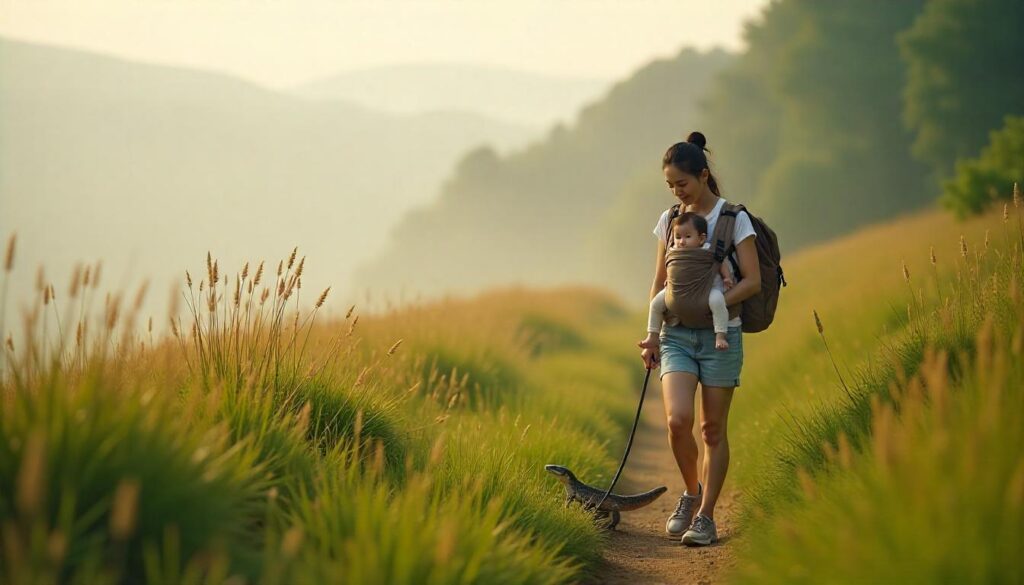
Ensuring safety while hiking with a baby is essential for a fun and stress-free outdoor adventure. From weather preparedness to wildlife awareness, taking proactive steps can make your experience enjoyable and secure.
How to Prepare for Weather Changes
Nature is unpredictable, and sudden weather changes can affect both babies and adults. Since infants have less-developed thermoregulation, they are more vulnerable to extreme temperatures. Preparing for heat and cold ensures a safe and comfortable hike for your baby.
Heat Protection for Summer Hiking
Hot weather can lead to dehydration, sunburn, and overheating, especially for babies. Keeping your little one cool and shaded is crucial when hiking in warm conditions.
Key Strategies for Hiking in the Heat:
- Hike Early or Late – Avoid midday sun exposure by hiking in the morning or evening when temperatures are cooler.
- Use a Baby Sunshade – A wide-brimmed hat and a UV-protective canopy on your baby carrier will keep them shaded.
- Dress in Lightweight, Breathable Clothing – Opt for loose, moisture-wicking fabrics that allow air circulation.
- Hydration is Essential – Babies who are breastfed or bottle-fed may need more frequent feeds to stay hydrated. If your baby is old enough, carry a hydration pack for toddlers to encourage regular drinking.
- Take Frequent Breaks – Stop in shady areas to cool down and monitor your baby for signs of overheating, like flushed skin or irritability.
Cold Weather Safety for Baby Hikers
Winter hiking presents different challenges, as babies lose body heat four times faster than adults. Proper layering and wind protection can prevent hypothermia or frostbite.
Essential Cold-Weather Hiking Tips:
- Dress in Layers – Use the three-layer system: a moisture-wicking base, an insulating middle layer, and a waterproof outer shell. Avoid cotton, as it retains moisture and cools the body quickly.
- Cover Extremities – Babies lose heat from their head, hands, and feet, so use a warm hat, mittens, and insulated booties.
- Keep the Baby Carrier Warm – If using a soft-structured carrier, tuck a fleece or insulated blanket around your baby.
- Monitor for Signs of Cold Stress – If your baby’s skin feels cold, they become lethargic, or they stop responding, immediately warm them up and seek shelter.
Wildlife Awareness & Trail Safety
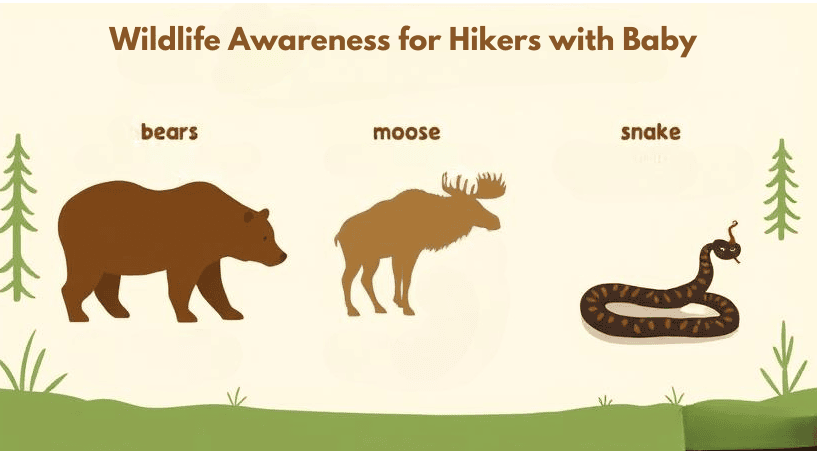
Hiking in wilderness areas means sharing trails with wildlife. Educating yourself on safe interactions and trail etiquette will protect both your baby and the environment.
Wildlife Encounters – What to Do
Wild animals are generally not aggressive, but improper behavior can provoke unwanted encounters.
Safety Tips for Common Wildlife in New Hampshire:
- Bears – Avoid attracting them by storing food securely, hiking in groups, and making noise to alert them of your presence. If you see a bear, back away slowly without turning your back. Never run.
- Moose – Moose may seem harmless, but they can charge if they feel threatened. Keep a safe distance, and if a moose appears agitated, retreat immediately.
- Snakes & Small Mammals – Most snakes in New Hampshire are non-venomous, but avoid touching them. Teach older toddlers not to pick up small animals, as they may bite when startled.
Leave No Trace Principles for Families
Teaching responsible hiking from an early age helps preserve natural spaces for future generations. Follow these simple Leave No Trace principles when hiking with a baby:
- Pack Out All Trash – Carry extra bags for diapers, wipes, and food wrappers.
- Stay on Marked Trails – Protect wildlife habitats by avoiding shortcuts and staying on designated paths.
- Respect Wildlife – Teach children to observe animals from a distance without disturbing them.
- Leave What You Find – Encourage toddlers to enjoy nature without picking flowers or removing rocks.
FAQs – Common Questions About Hiking with a Baby
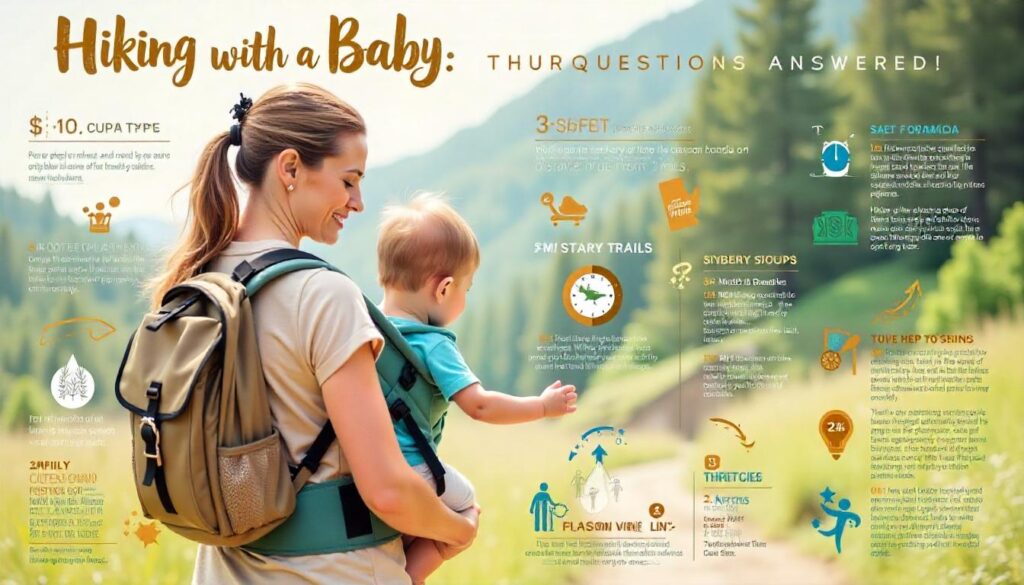
What is the best age to start hiking with a baby?
Babies can start hiking as early as newborns, but parents should consider baby’s neck strength, feeding needs, and weather conditions. For newborns (0-3 months), short, shaded walks are best. By 4-6 months, babies can handle longer hikes in proper carriers.
What’s the safest way to carry a baby on a hike?
The best option depends on your baby’s age and the terrain.
- 0-6 months: A soft-structured carrier (like an Ergobaby) supports the baby’s head and spine.
- 6+ months: A framed hiking carrier provides better support for longer hikes and allows the baby to see the surroundings.
How long can a baby safely be in a carrier on a hike?
Most pediatricians recommend limiting carrier time to 1-2 hours at a stretch. Babies need frequent breaks to stretch, feed, and change diapers.
What’s the best hike for beginners with a baby?
Beginners should choose flat, well-maintained trails with short distances (1-2 miles). Ideal hikes include state parks, nature preserves, and lakeside trails with benches and shade.
Conclusion – Make Your First Baby Hike a Success
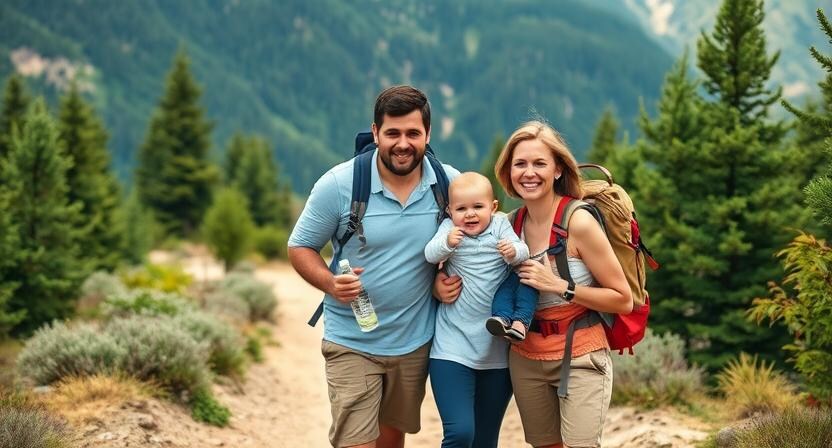
Hiking with a baby may seem overwhelming at first, but with the right mindset, preparation, and gear, it can become one of the most rewarding experiences for both parents and little explorers. The key is to start small, plan ahead, and be flexible with your expectations. Whether you’re enjoying a short nature walk or gradually increasing the distance as your child grows, each hike helps create lasting memories and fosters a deep connection with the outdoors.
As you gain confidence, you’ll discover that hiking with a baby isn’t just about getting fresh air—it’s about encouraging curiosity, teaching resilience, and building a love for nature from an early age. Investing in quality baby hiking gear, choosing baby-friendly trails, and staying mindful of weather conditions and safety will ensure a smooth and enjoyable adventure for both you and your child.
Looking for more hiking guides? Check out our detailed guides on hiking for beginners, what to bring on a hike, and also don’t miss Hiker Rescue Bill New Hampshire.
Have you ever hiked with a baby? Share your experiences in the comments below! What worked well for you? What challenges did you face? Let’s build a supportive community and help more parents confidently explore the outdoors with their little ones.
Ethan Marlowe is an experienced hiker and outdoor gear specialist based in Colorado. With over 7 years of hands-on experience trekking through the Rockies, Pacific Northwest, and East Coast trails, he delivers practical advice, expert gear reviews, and survival insights. His goal is to help hikers of all levels make smarter decisions on and off the trail.

